Space Shuttle Launch Complex 39-B Construction Photos
Page 29
The View
(Original Scan)
Mixed Images.
Top left has an FSS that is still red.
Top right is looking at the shadow of the towers, cast all the way to the LOX tank.
Bottom left is the Flame Trench with Side Flame Deflector and Sound Suppression Water Spray Headers, North Piping Bridge, and cabling crossover platforms on the Hinge Column of the RSS.
Bottom right is looking along the length of the boom of the Hammerhead Crane, out toward the ocean.
Additional commentary below the image.
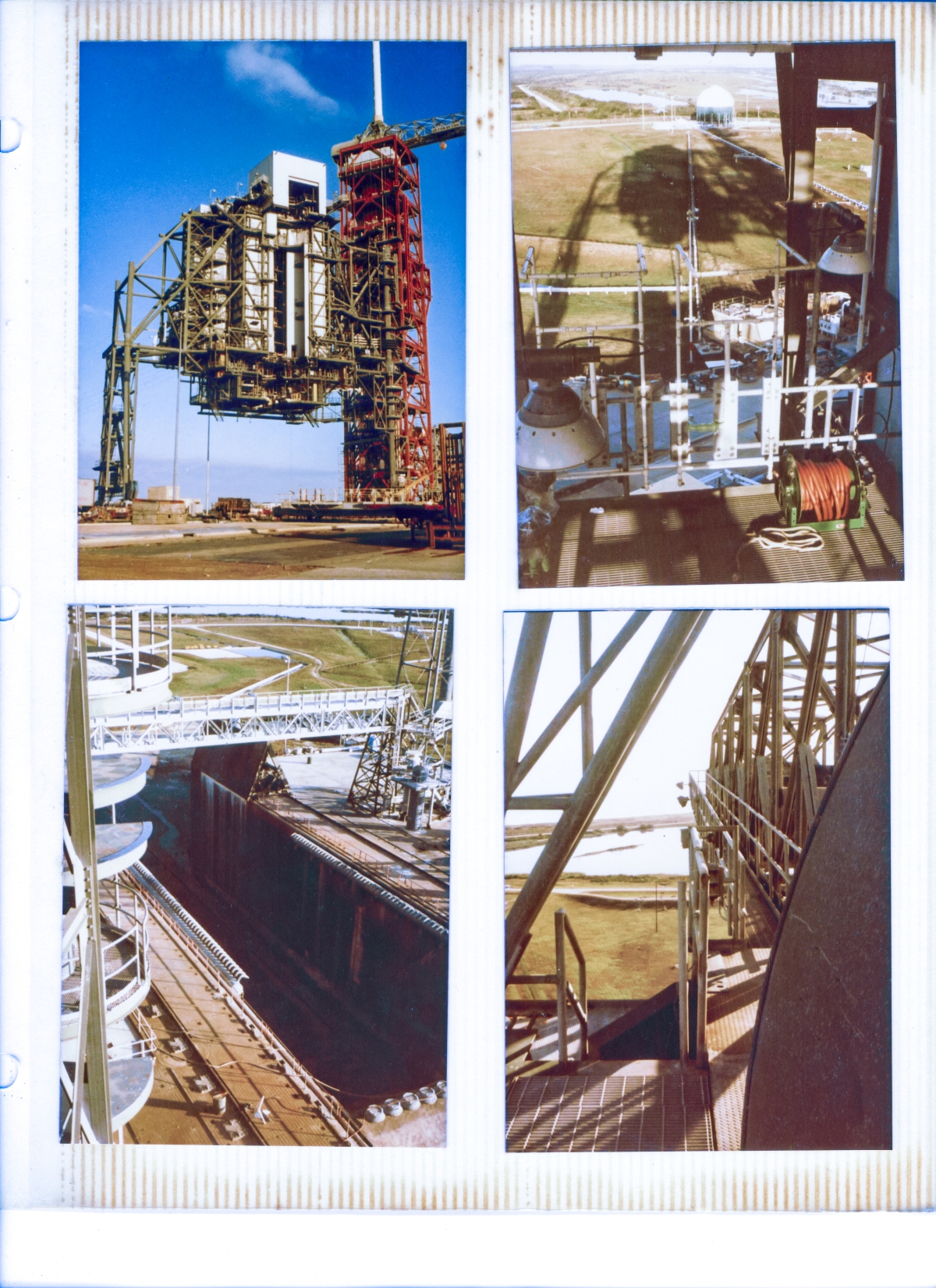
Top Left: (Full-size)
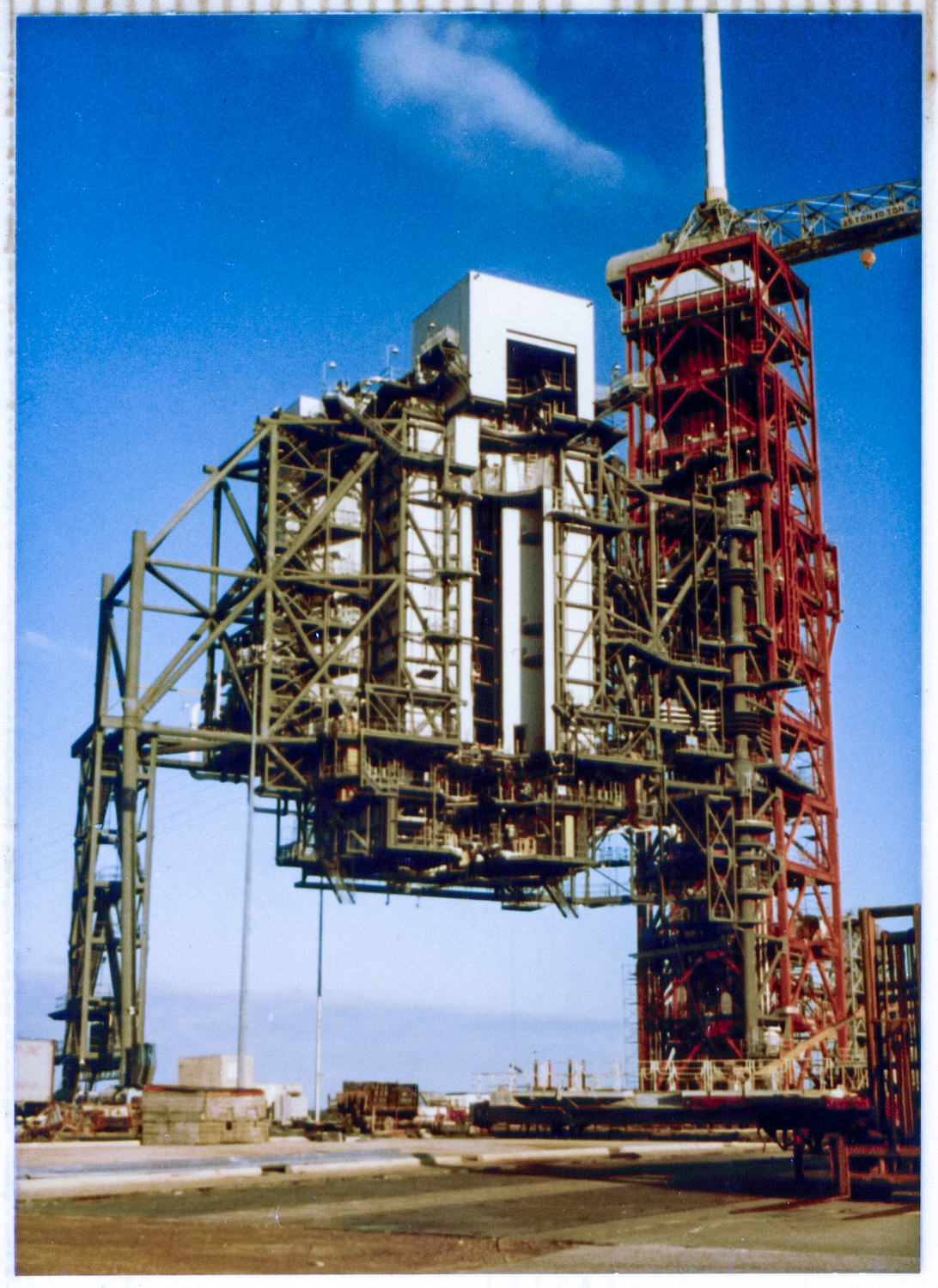
Early morning.
This shot was taken toward the end of my Sheffield Steel days, with the main body of the RSS fully complete, but before all of the miscellaneous metals, piping, cabling, and equipment installations which occurred during my Ivey Steel days were put into place.
This would therefore be some time in the first quarter of 1982, probably January or February most likely, as evidenced by the angle of the morning shadows, especially the shadow cast by the horizontal Column Line 7 main-framing member at elevation 171' between Lines A and B, that is being cast on the vertical main-framing member at Column Line A-7 between elevations 135' and 171' which is indicating that the sun, low above the eastern horizon, is quite a bit south of due east.
A glance at the FSS shows that there are no swing arms attached to it yet. No GOX Arm, no OAA, no IAA. The red paint on the FSS is another indication of when this photo was taken. The towers were completely sandblasted and recoated, pearl gray epoxy top coat, during the time between erection of the primary structure with its secondary framing, and the piping, cabling, and equipment installations which followed.
So we find ourselves looking at things as good old contract NAS10-9655, Pad 39B Phase II, was drawing to a close.
Without all the subsequent encrustations of Orbiter Weather Protection, Guide Columns System, Orbiter Mid-Body Umbilical Unit, swing arms, strongbacks, latchbacks, Centaur Porch, access platforms, scrubbers, panel boxes, conduit, cabling, piping, and no end of other stuff, it becomes a bit less difficult to recognize and identify the main elements of both the FSS and the RSS.
We are located a little ways south and east of the southern end of the flame trench, just beyond the area where the flat and level expanse of the pad deck proper begins gently curving downhill and becomes the pad slope.
At ground level, in the middle distance, beyond and immediately to the left of the forklift and the end of the empty flatbed semi trailer parked right beside it, blocking the view of the FSS at ground level, you can see some of the lighter gray framing of the Engine Service Platform, as well as some of the handrail on top of it.
The ESP rolled on rails that ran just inboard of the two crawlerway trackways, and it could be rolled a pretty good ways down the pad slope to a park position when not in use, or it could be brought all the way up to a position on the pad deck where it sat directly beneath the MLP.
It was a big item, spanning the 58 foot width of the flame trench, was built sturdy to carry some substantial loads, and had a footprint perhaps of similar size to the front lawn, and maybe part of the house, in a typical suburban subdivision.
It was low and wide and strong, and it was used to place additional platforms on top of it, for use when it was under the MLP, to provide access to the Space Shuttle's main engines (hence its name Engine Service Platform), should it become necessary for personnel to get to them once the bird was on the pad.
And the story was told, whether true or not I do not know at this time, that during Apollo 10, which was the only moon mission that flew on a Saturn V from Pad B, they, for unknown reasons, did not roll the ESP all the way down the pad slope, but instead simply pulled it back part way and left it there.
The story goes on to say that when the Saturn V lit up and took off, the volcano of exhaust coming up and out of the south end of the flame trench managed to catch the edge of the ESP, and flipped it into the air and kicked it all the way down to the bottom of the pad slope, a distance of almost a quarter of a mile.
Giant steel contraption, bigger and heavier than your house, flipped like an empty pizza box, nearly a quarter mile!
I strongly suspicion that this story is true.
That goddamned Saturn V was just something else. Something beyond proper human understanding.
Top Right: (Full-size)
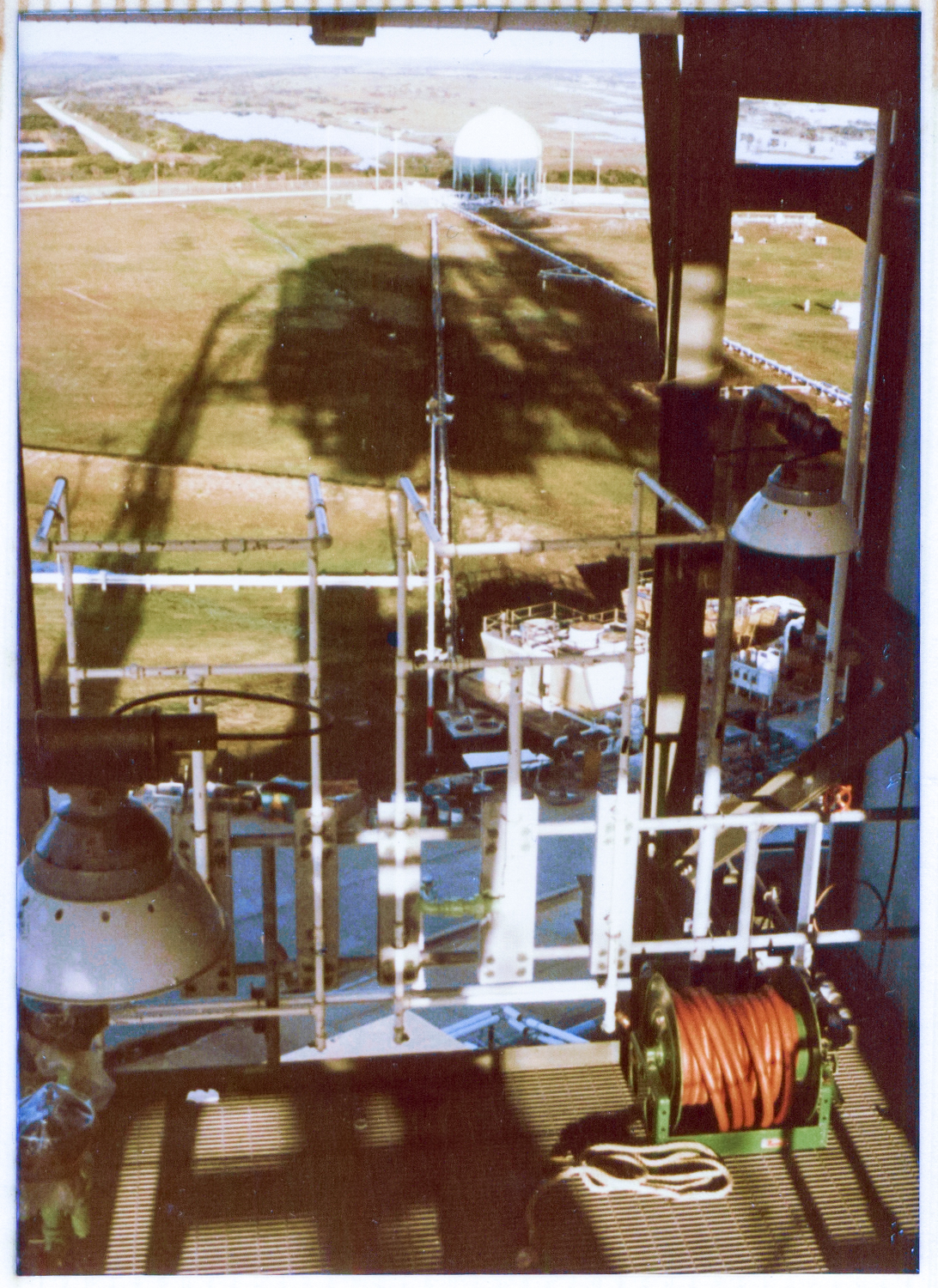
Early morning. Beautiful Florida day.
You're on the lower portion of the RSS, standing midway on the stair that takes you down to the lowest platform framing elevation at 112', looking northwest at the shadow cast by the towers for a full quarter mile, all the way out to the Lox Tank, with an emergency shower and hose reel there on the platform framing below and in front of you.
This picture in no way conveys the immensity and grandeur of what it's showing, although that feeling was strong in me when I took this shot.
You'd walk around on the towers, and stuff like this would jump out at you from around hidden corners all the time and yet I never heard from a single other person about any of it.
It was as if they all had just decided to block it completely out, put their heads down as far as they could, and never let any of it enter their minds.
I never did, and never will, understand this mentality.
It just completely escapes me.
The beauty, the majesty, the symmetry, the power, the form, the otherworldly grace, and all the rest of it were arrayed everywhere around everyone, and yet none of them responded to any of it that I can recall.
I don't know.
I just do not know.
Bottom Left: (Full-size)
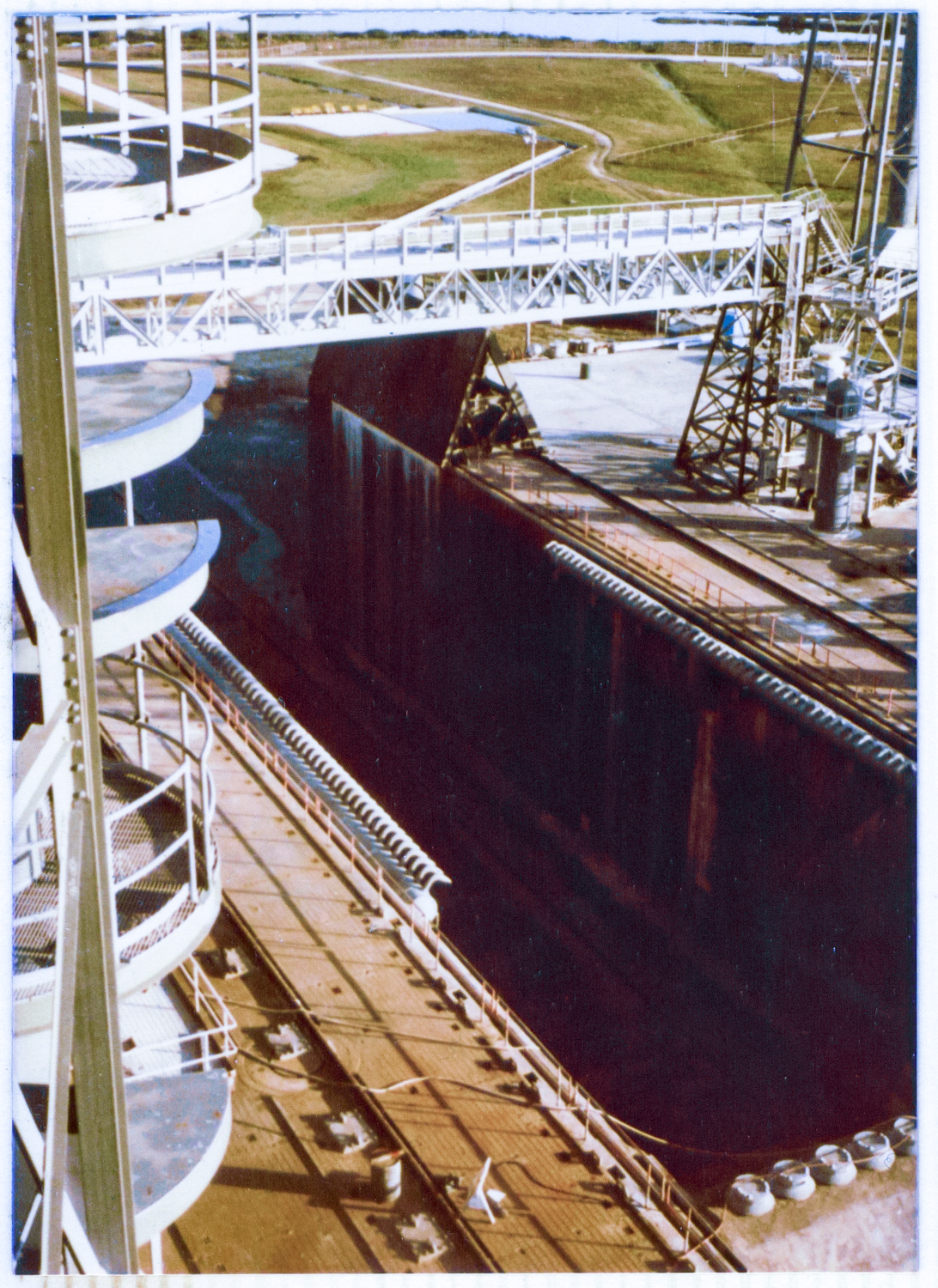
North side of the flame trench.
Yet another example of the immensity and scope of things out on the pad.
You're on the 125' level of the RSS, on the corner closest to the hinge column, and in the top left corner of the image, you can see part of the lower hinge column thrust-bearing access platform (which is recognizable as such by having steel-bar grating and handrail) along with a couple of hinge column cable or ducting crossover platforms below it (no grating, no handrail).
In the middle distance, the north piping bridge spans the flame trench and the east Side Flame Deflector perches right on the edge of the precipice, and beyond that, in the grassy area beyond, one of the two (the other is out of view, to the left of this frame, west of the north/south centerline of the Flame Trench) rectangular water-retention areas where SSW deluge water was temporarily held, immediately following launch, along with the drainage ditch which led to it. And beyond that, beyond the gentle curve of the pad perimeter road, deceptively-placid waters of the Merritt Island Wildlife Refuge reflect the sky above them, hiding no end of living things which wait there, unseen.
That's a five story deep cut into the concrete of the pad you're looking into.
And on all three surfaces of this cut, khaki-yellow refractory bricks (the stuff that lines the insides of blast furnaces) are burnt black, and their surfaces in many places are rendered smooth and nearly glass-like, by the stupendous exhaust of the Saturn Rockets that flew from this very place.
Blast furnaces do not fly.
But Saturn Rockets did.
And so did Space Shuttles.
Bottom Right: (Full-size)
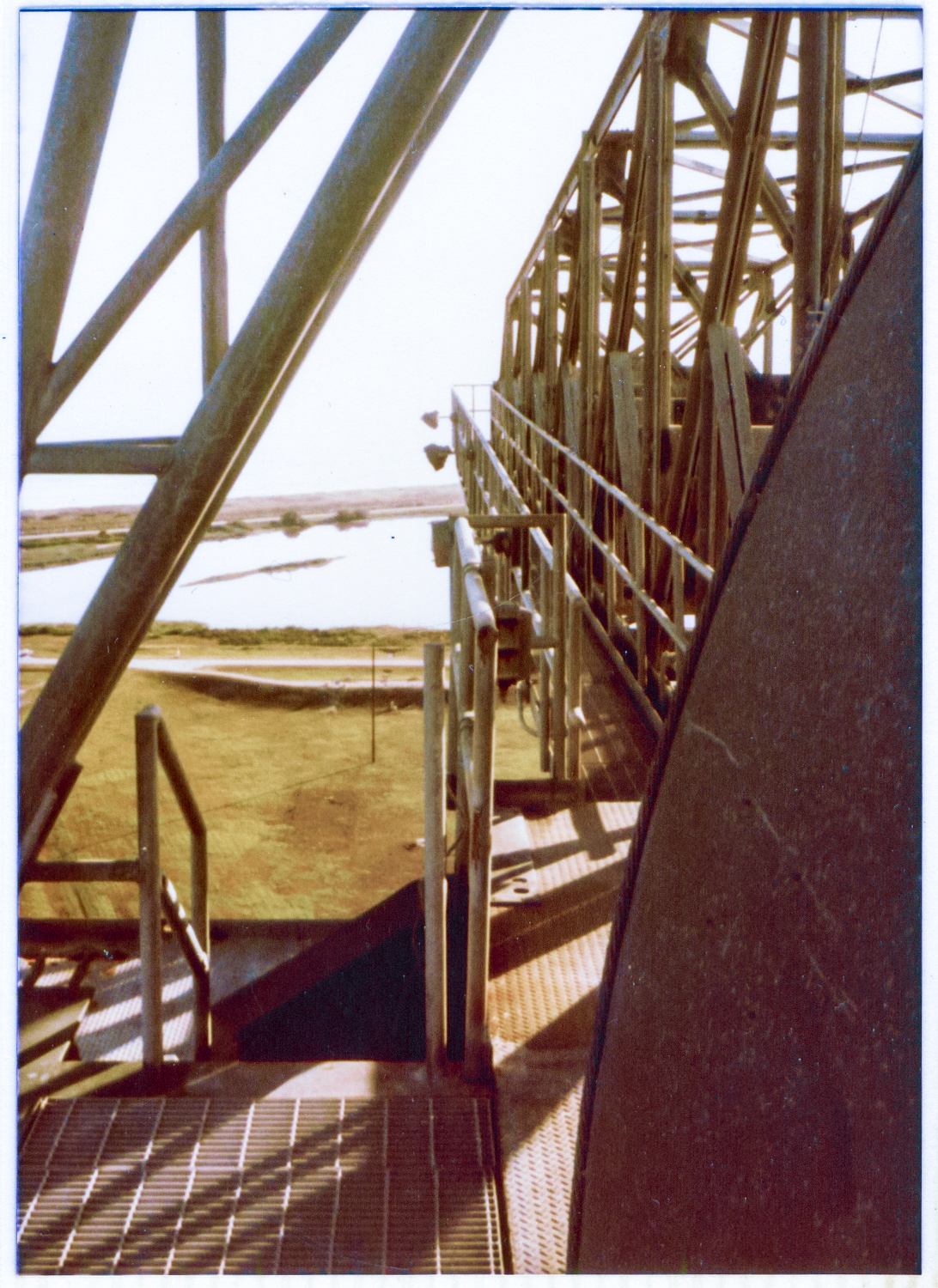
View from the hammerhead crane.
You're looking east, toward the overexposed sky and ocean, out beyond the dune line that fronts the beach itself.
You're over three-hundred feet above the expanse of nice green grass that surrounds the camera pad that's located just inboard, along the pad perimeter road in the distance due east of the center of the pad, standing above the top of the FSS, on the main working level of the crane itself.
Look close, between and to the left of the sloping handrails that are on either side of the unseen stair just beyond the far edge of the steel bar grating, and you can see that there is checkered deck plate, with a four-inch high steel toe plate at its far edge, but no handrail.
You are above the top level of the FSS, and the checkerplate up there can have no handrail because the crane boom rotates freely through 360 degrees of travel, and would interfere with anything at all that protruded upwards from that checkerplate any more than the toe plate does.
Mind what you're doing when you're over there by that toe plate, ok?
There's nothing at all to stop you over there, and it's a long way down to the bottom.
Return to 16streets.comACRONYMS LOOK-UP PAGEMaybe try to email me? |